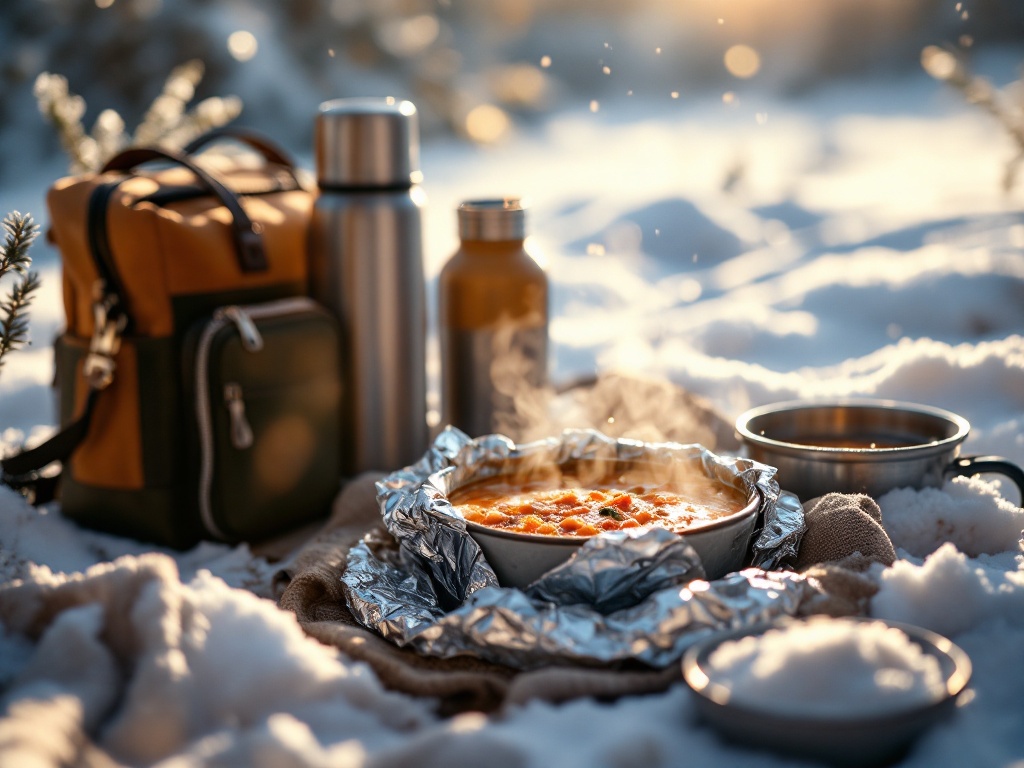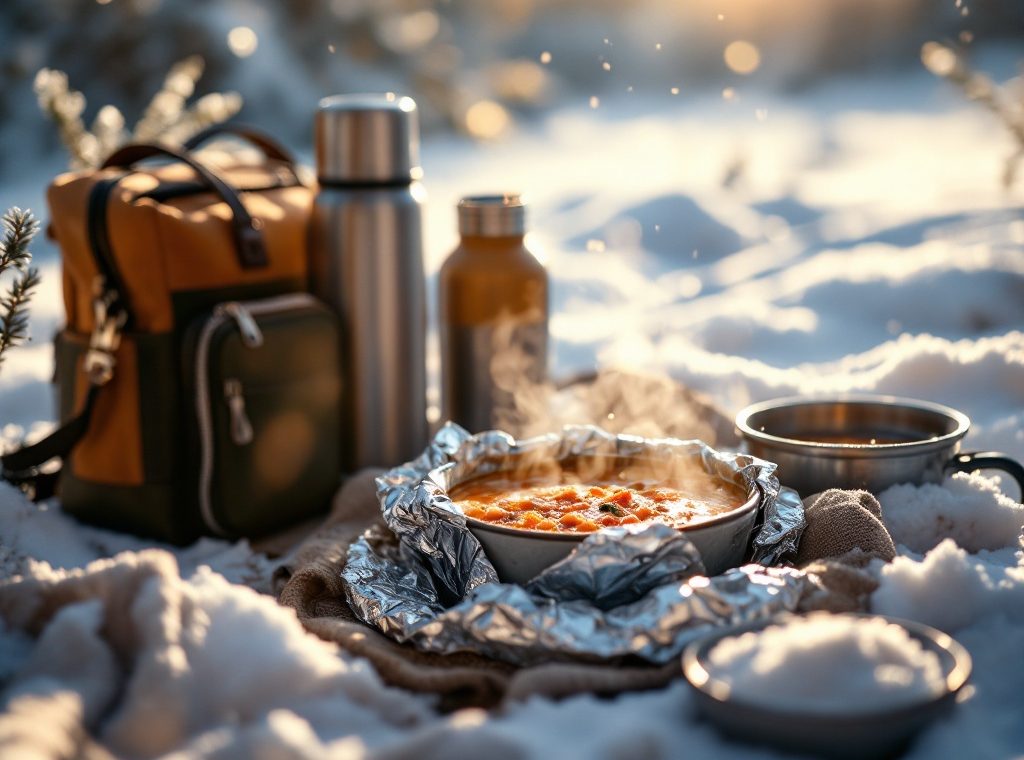How to Keep Food Warm while Traveling in Winter
Tired of cold meals on your winter journeys? Discover how to keep your food piping hot and delicious, no matter how low the temperature drops. Learn simple yet effective techniques, from pre-heating containers and utilizing aluminum foil to leveraging the power of insulated bags, thermoses, and even hot water bottles. Explore the benefits of different cookware and containers, ensuring your winter meals stay warm and safe to eat, maximizing your enjoyment on any chilly adventure. Read on to unlock the secrets to warm winter dining.
Important information

- Insulated containers, like thermoses, are key for keeping food warm for hours on winter trips. Preheat them with hot water before adding food.
- Wrap food in foil for extra insulation, and wrap containers in towels or blankets for even more warmth.
- Heat packs or portable food warmers provide additional heat for longer trips and outdoor activities.
- For large quantities of food, use insulated thermal bags with hot water packs or heated bricks for extended warmth.
- Maintaining warm food temperatures prevents bacterial growth and foodborne illness.
Choosing the Right Cookware and Containers
Ceramic cookware and heavy cast iron pots excel at heat retention, making them perfect for keeping food warm.
Glass containers offer visibility and decent insulation, though not as effective as a thermos.
Thermoses and vacuum flasks provide superior insulation, ideal for individual portions.
For winter outings, consider a ceramic pot for a main course, and a thermos for soup or a hot drink.
Advantages of Heavy Pots and Cast Iron
Cast iron pots, known for their heft, are ideal for winter travel. Their exceptional heat retention ensures even cooking and prevents hot spots, keeping food at a consistent temperature. This is perfect for slow-cooked meals and maintaining ideal serving temperatures, while also minimizing scorching. The pots’ ability to stay warm long after being removed from the heat source ensures your food remains enjoyable throughout your journey.
Using Thermoses and Vacuum-Insulated Flasks
Thermoses and vacuum flasks are excellent for keeping food hot for hours, which makes them perfect for winter outings. Their vacuum seal prevents heat transfer, so soups and stews stay piping hot without needing electricity like electric warmers do.
Essential Insulation Methods
Maintain ideal food temperatures with easy insulation methods.
- Insulated containers excel at preserving temperatures for extended periods.
- For larger quantities, thermal bags are a practical choice.
- Aluminum foil reflects heat, keeping food warm.
- Towels or newspapers provide additional insulation by trapping warm air.
- For enhanced temperature control, consider insulated liners to improve the effectiveness of containers and bags.
Insulated Containers and Their Benefits
Insulated containers are essential for maintaining food temperature and preventing spoilage. Double-walled designs effectively keep food hot for around 12 hours. For superior heat retention, especially with soups and stews, vacuum-insulated containers are ideal. Durable stainless steel and glass options are available. Choose leak-proof containers with wide mouths for easy filling and serving. Some even include built-in heaters, a convenient feature for travel. Consider these factors when selecting an insulated food container:
Insulation Type
- Double-walled: effective for general use, keeping food hot or cold for several hours.
- Vacuum-insulated: superior heat retention, ideal for hot soups, stews, and extended temperature control.
Material
- Stainless steel: durable, resistant to rust and odors.
- Glass: retains heat well, easy to clean, but can be more fragile.
Look for leak-proof containers with wide mouths for convenient filling and serving. Built-in heaters offer added convenience, especially when traveling.
Using Thermal Bags for Large Portions
Thermal bags are ideal for transporting large quantities of food, such as casseroles, roasted chickens, or multiple meal preps. Their insulation maintains food temperature. For hot dishes, adding hot water packs or towel-wrapped heated bricks extends warmth even further.
The Role of Insulated Liners in Temperature Maintenance
Insulated liners are essential for maintaining food warmth in coolers and thermal bags. They create a thermal barrier that minimizes heat transfer, keeping food warm during travel and preventing temperature loss. This helps ensure both food safety and flavor. These liners make coolers particularly useful in winter for preserving warm food temperatures.
Innovative Ways to Retain Heat
Heat packs provide sustained warmth, while hot water bottles offer portable comfort. Both are excellent for keeping food warm on the go. Simply wrap your food containers in them for optimal heat retention.
Boosting Heat Retention with Aluminum Foil
For optimal heat retention, use aluminum foil. Its reflective properties minimize heat loss. Wrapping food in multiple layers of foil creates an insulating barrier, effectively trapping warmth.
Enhancing Insulation with Towels and Newspapers
Towels and newspapers can also boost insulation. Wrapping containers in these materials adds another protective layer, helping food stay hot longer. The more layers you use, the better the insulation.
Utilizing Heat Packs and Hot Water Bottles
Keep your winter meals warm on chilly outdoor adventures. Use heat packs or hot water bottles placed next to your food in an insulated container. This simple trick helps maintain warmth, making winter dining enjoyable. A hot water bottle filled with boiling water provides long-lasting heat. Heat packs offer varying durations depending on their type and size. Both are safe to use near food; simply wrap them in a cloth or towel to avoid direct contact and prevent burns. Enjoy a warm meal, no matter how cold it is outside.
Maximizing Heat Retention with Aluminum Foil
Aluminum foil’s reflective surface helps keep food warm by bouncing heat back towards it, thus slowing the cooling process. Wrapping food tightly in foil provides further insulation, and combining it with an insulated container or thermal bag, especially in winter, significantly improves heat retention, making it easier to transport warm meals. While effective, foil isn’t a perfect insulator; it primarily maintains existing temperatures.
Leveraging Towels and Newspapers for Insulation
Keep your food warm on winter trips using common household items like towels and newspapers. These act as effective insulators, creating air pockets that trap warmth and prevent heat loss. Wrap your hot food containers tightly in towels or use crumpled newspaper for insulation. Fill empty spaces in your cooler or insulated bag with loosely crumpled newspaper balls to reduce air circulation and maximize insulation, keeping your meals hotter for longer.
Practical Tips for Food Transport
Use pre-heated containers or insulated wraps for hot dishes to maintain safe temperatures. Ensure food is thoroughly cooked and piping hot when packed.
Pack food in clean, dry containers, avoiding overfilling. Insulated bags or coolers are excellent choices, and adding towels or newspaper provides extra insulation.
Frequently check the food’s temperature and eat it promptly. Be mindful of condensation, as it can quickly cool food down.
Separating Hot and Cold Foods During Travel
When traveling, maintain food safety by keeping hot items hot and cold items cold. This preserves both quality and freshness. Placing hot food next to cold items can lower its temperature, potentially making it unsafe for consumption. Separate hot and cold foods in your cooler or insulated bag to maintain safe temperatures and prevent cross-contamination. For example, use separate containers for hot soup and a cold salad.
Pre-heating and Pre-cozying Techniques
Enjoy warm meals on your winter adventures! Pre-heating your food containers with hot water before adding your food is a simple yet effective way to maintain the ideal temperature. Pot cozies, often crafted from insulating fabrics, are another essential item. By slowing heat loss, these handy covers keep your food warmer for extended periods, making them perfect for travel. Here’s how to keep your meals warm on the go:
- Pre-heat containers: rinse your food containers with hot water before adding your meal to help maintain its temperature,
- Use pot cozies: these insulated covers slow down heat loss, keeping your food warm for longer,
- Insulated bags: store your food containers in an insulated bag for added protection against the cold.
Creative Solutions for Winter Adventures
Portable food warmers are ideal for keeping meals hot during winter picnics and hikes, allowing you to enjoy warm stews, soups, or chili even in cold weather.
While pre-made meals are excellent for picnics, hikers might prefer convenient, energy-boosting snacks like trail mix, energy bars, and dried fruit.
Using Travel-Sized Food Warmers
Portable food warmers are ideal for maintaining your meal’s temperature while on the go. These devices are perfect for outdoor activities like picnics or hikes, especially in colder weather. Many warmers operate on batteries, with some models offering rechargeable options for added convenience. Others plug into a car’s 12V outlet, making them perfect for road trips. Available in various sizes, you’ll find one that fits your meal perfectly. When choosing a warmer, consider its heat retention capabilities, power source, and capacity. For extra warmth, use food-safe heating packs inside insulated containers or thermal bags.
Preparing for Winter Picnics and Hiking
Fuel your winter adventures with smart food choices. For energizing snacks during hikes, consider nuts, dried fruit, and energy bars. Packable meals such as sandwiches, wraps, and salads (avoid mayonnaise, as it freezes) are also excellent choices. For a warming meal, pack hearty soups or stews in an insulated container. Hot drinks like tea, coffee, or hot chocolate provide additional warmth. Staying hydrated is crucial even in the cold, so bring plenty of water. A portable stove with fuel can be invaluable for heating water or preparing simple meals.

















